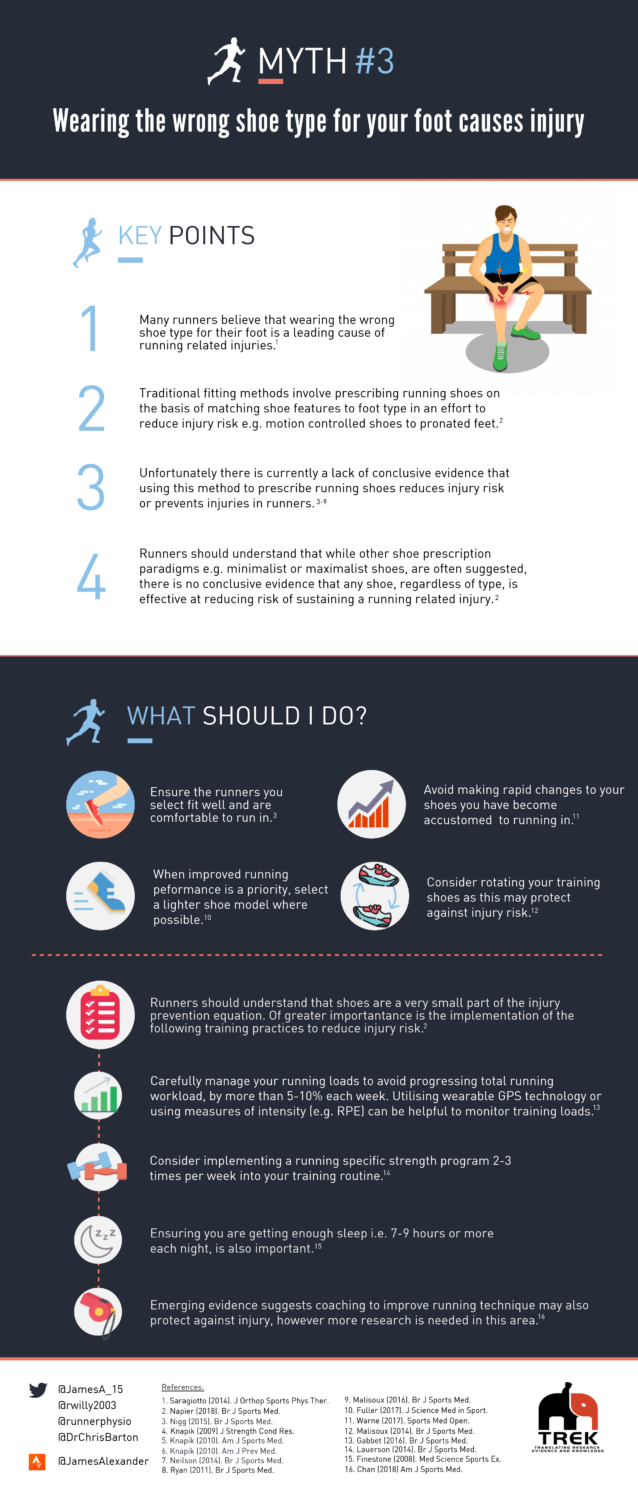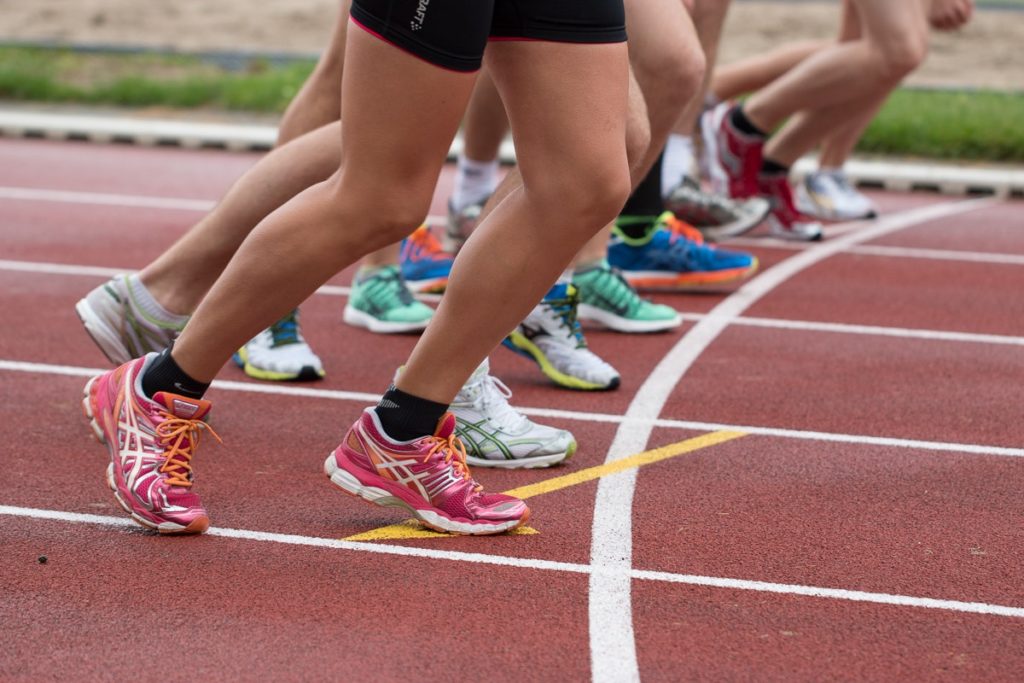Many runners believe that wearing the wrong shoe type for the foot is a leading cause of running related injuries.1 This belief stems from traditional shoe prescription methods where running shoes are prescribed on the basis of matching shoe features to foot type e.g. motion controlled shoes to pronated feet.
Unfortunately there is a lack of conclusive evidence to support such beliefs.2
 There are currently five high quality research studies, which demonstrate that traditional shoe prescription does not prevent running related injuries in groups of novice runners3, female runners4 or in military training populations.5–7 However a recent study has challenged these findings. In a group of recreational runners who were prescribed either a motion control or neutral shoe and followed for six months, a motion control shoe provided some protection against injury in runners with a pronated foot type.8
There are currently five high quality research studies, which demonstrate that traditional shoe prescription does not prevent running related injuries in groups of novice runners3, female runners4 or in military training populations.5–7 However a recent study has challenged these findings. In a group of recreational runners who were prescribed either a motion control or neutral shoe and followed for six months, a motion control shoe provided some protection against injury in runners with a pronated foot type.8
With such conflicting findings, further high quality research is required to determine the most effective shoe prescription system.9 In the meantime runners should understand that while other shoe prescription paradigms e.g. minimalist or maximalist shoes, are often suggested, there is no conclusive evidence that any shoe, regardless of type, is effective at reducing risk of sustaining a running related injury. Of greater importance is the implementation of appropriate training strategies, which have been demonstrated to reduce the incidence of injuries in runners (see below).
Important points to consider when purchasing a new pair of runners:
- Ensure the runners you select fit well and are comfortable to run in.2
- Avoid making rapid changes to the type of shoe you have become accustomed to running in. For example changing straight to a minimalist shoe from a heavier motion control shoe. Instead make a gradual transition over several months.10
- When improved running performance is a priority, select a lighter shoe model.11
- Consider rotating between two or more pairs of runners for training. This has been shown to have a small protective effect against injury.12
To reduce your risk of sustaining a running related injury, consider implementing the following strategies into your training routine:
Careful management of training loads is important to reduce injury risk.13 Avoid progressing your total running load (e.g. distance, time, or intensity) by more than 5-10% each week to ensure your body has time to adapt to the training stimulus, and the risk of tissue overload is minimised.13 Wearable technology such as GPS monitors or using the rating of perceived exertion (RPE) to measure training intensity, can assist in monitoring training loads. However, research has not yet determined what is the most important training metric e.g., duration, intensity, etc., when it comes to reducing risk of running related injury.
Completing a strength training program consistently 2-3 times per week for longer than 6 weeks has also been shown to reduce risk of overuse injuries in running populations14 and improve running performance.15 For further information on strength training for runners click here to read a recent blog on this topic.
Ensuring you are getting enough sleep i.e. 7-9 hours or more each night, is also important. For instance, adequate sleep may reduce the risk of stress fractures in running populations.16 Getting more sleep has proven beneficial effects on performance and recovery.17
Emerging evidence also suggests that improving running biomechanics through specific coaching of technique may lower the risk of sustaining a running related injury, in addition to reducing loading rates18, however further research is required in this area.
It is important to remember that the information provided above, although evidence based, is general in nature. Runners should consult a health professional who has experience working with runners for advice on reducing injury risk specific to their individual circumstances.
References:
-
Saragiotto, B. T., Yamato, T. P., & Lopes, A. D. (2014). What do recreational runners think about risk factors for running injuries? A descriptive study of their beliefs and opinions. Journal of Orthopaedic & Sports Physical Therapy, 44(10), 733-738.
-
Nigg, B. M., Baltich, J., Hoerzer, S., & Enders, H. (2015). Running shoes and running injuries: mythbusting and a proposal for two new paradigms: ‘preferred movement path’ and ‘comfort filter’. British Journal of Sports Medicine 49(20), 1290-1294.
-
Nielsen, R. O., Buist, I., Parner, E. T., Nohr, E. A., Sørensen, H., Lind, M., & Rasmussen, S. (2014). Foot pronation is not associated with increased injury risk in novice runners wearing a neutral shoe: a 1-year prospective cohort study. British Journal of Sports Medecine, 48(6), 440-447.
-
Ryan, M. B., Valiant, G. A., McDonald, K., & Taunton, J. E. (2011). The effect of three different levels of footwear stability on pain outcomes in women runners: a randomised control trial. British Journal of Sports Medicine, 45(9), 715-721.
-
Knapik, J. J., Trone, D. W., Swedler, D. I., Villasenor, A., Bullock, S. H., Schmied, E., … & Jones, B. H. (2010). Injury reduction effectiveness of assigning running shoes based on plantar shape in Marine Corps basic training. The American journal of sports medicine, 38(9), 1759-1767.
-
Knapik, J. J., Swedler, D. I., Grier, T. L., Hauret, K. G., Bullock, S. H., Williams, K. W., … & Jones, B. H. (2009). Injury reduction effectiveness of selecting running shoes based on plantar shape. The Journal of Strength & Conditioning Research, 23(3), 685-697.
-
Knapik, J. J., Brosch, L. C., Venuto, M., Swedler, D. I., Bullock, S. H., Gaines, L. S., … & Jones, B. H. (2010). Effect on injuries of assigning shoes based on foot shape in air force basic training. American journal of preventive medicine, 38(1), S197-S211.
-
Malisoux, L., Chambon, N., Delattre, N., Gueguen, N., Urhausen, A., & Theisen, D. (2016). Injury risk in runners using standard or motion control shoes: a randomised controlled trial with participant and assessor blinding. British Journal of Sports Medicine, 50(8), 481-487.
-
Napier, C., & Willy, R. W. (2018). Logical fallacies in the running shoe debate: let the evidence guide prescription. British Journal of Sports Medicine, Online editorial, Doi: 10.1136/bjsports=2018-100117
-
Warne, J. P., & Gruber, A. H. (2017). Transitioning to minimal footwear: A systematic review of methods and future clinical recommendations. Sports medicine-open, 3(1), 33.
-
Fuller, J. T., Thewlis, D., Tsiros, M. D., Brown, N. A., & Buckley, J. D. (2017). Six-week transition to minimalist shoes improves running economy and time-trial performance. Journal of science and medicine in sport, 20(12), 1117-1122.
-
Malisoux, L., Urhausen, A., & Theisen, D. (2014). Impact of training characteristics on running-related injuries in recreational runners. British Journal of Sports Medicine, 48(7), 631-632.
-
Gabbett, T. J. (2016). The training—injury prevention paradox: should athletes be training smarter and harder? British Journal of Sports Medcine, 50(5), 273-280.
-
Lauersen, J. B., Bertelsen, D. M., & Andersen, L. B. (2014). The effectiveness of exercise interventions to prevent sports injuries: a systematic review and meta-analysis of randomised controlled trials. British Journal of Sports Medicine, 48(11), 871-877.
-
Rønnestad, B. R., & Mujika, I. (2014). Optimizing strength training for running and cycling endurance performance: A review. Scandinavian journal of medicine & science in sports, 24(4), 603-612.
-
Finestone, A., & Milgrom, C. (2008). How stress fracture incidence was lowered in the israeli army: a 25-yr struggle. Medicine and Science in Sports and Exercise, 40(11 Suppl), S623-9.
-
Bonnar, D., Bartel, K., Kakoschke, N., & Lang, C. (2018). Sleep interventions designed to improve athletic performance and recovery: a systematic review of current approaches. Sports medicine, 48(3), 683-703.
-
Chan, Z. Y., Zhang, J. H., Au, I. P., An, W. W., Shum, G. L., Ng, G. Y., & Cheung, R. T. (2018). Gait retraining for the reduction of injury occurrence in novice distance runners: 1-year follow-up of a randomized controlled trial. The American Journal of Sports Medicine, 46(2), 388-395.

